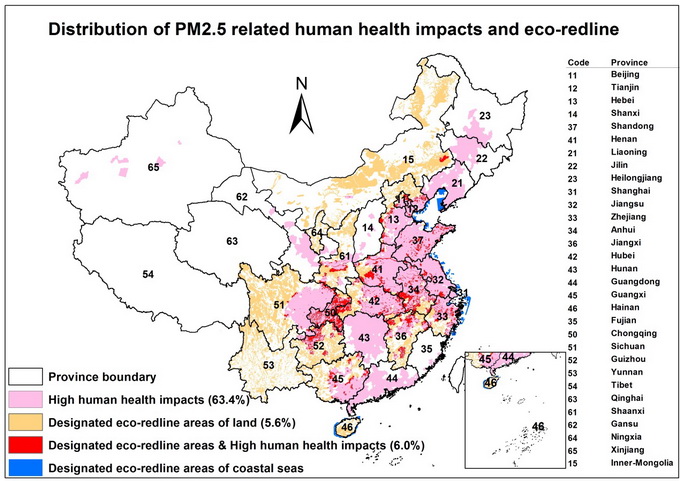A research team led by Prof. Chunsheng Hu and Lin Ma from the Center for Agricultural Resources Research, Institute of Genetics and Developmental Biology, CAS studied ‘Further improvement of air quality in China needs clear ammonia mitigation target’. Their findings were published in Environmental Science &Technology.
Heavy air pollution has impacted strongly on the quality of life in China. The poor air quality has serious impacts on human health and reduces life expectancy. While the causes of these high pollution episodes in China are not yet fully understood, many contributing factors have become clear. Highest PM2.5 concentrations appear under stagnant weather conditions, with secondary inorganic aerosols playing a key role. China’s government has implemented several strict policies to control air pollution, including the Blue Sky Protection Campaign in 2018. This policy has set targets for SO2, NOx and PM2.5 emissions for 2020, requiring respective reductions of 15, 15 and 18%, compared with 2015. This policy has triggered large changes, including improvements in energy efficiency and the relocation or closure of selected heavy industries. However, no emission reduction target was set for NH3 emissions.
To combat similar problems, the European Union established the National Emission Ceilings Directive as a legislative framework to limit national total emissions of five compounds - SO2, NOx, volatile organic compounds (VOCs), NH3 and PM2.5. Based on country specific analyses of pollution impacts and of air pollution control costs while considering paths of future economic growth, country-specific reduction targets for 2020 and 2030 have been agreed. In China, ambient PM2.5 and SO2 concentrations declined by 42% and 68% in 74 cities between 2013 and 2018. However, the current policy of pushing for primary PM2.5, SO2, NOx, has its limitations and possibly becomes soon very cost-ineffective as marginal costs of further control for some of the pollutants are very high. We argue that multipollutant mitigation targets are needed for China, most urgently to deliver NH3 emission reductions. Here we develop the scope and the pathway towards establishing such mitigation targets.
Human health impacts due to atmospheric PM2.5 must lie at the core of such mitigation targets. Prioritizing NH3 reductions in such a strategy allows several ecosystem goals to be addressed simultaneously. The sensitivity of ecosystems to nitrogen loads is well known, and the threats of acidification, eutrophication and consequential loss of biodiversity played a key role in the development of European policy. Ecologically sensitive regions of natural forest, grassland and wetlands, including the coastal seas, should be protected in addition to those where the protection of human health is most urgent (see Fig 1). Further studies are needed to evaluate the sensitivities of these regions to N deposition and soil acidification. This could be linked to the Ecological Red-Line designation.
Avoiding pollution swapping between regions must be considered, recognizing potential conflicts in simultaneously trying to achieve goals of protecting soil, water and the atmosphere. There may be interactions between measures specifically addressing losses to air or water. Thus, strategies designed to achieve the regional NH3 emission ceilings need also to consider the risk of water pollution, particularly with reference to any proposed Nitrate–Vulnerable-Zones in China. Setting ammonia mitigation targets requires a clear understanding of the relationship between emissions and impacts, with the aim of reducing impacts at minimal cost. The level of socially acceptable impact, or of the economically acceptable cost, then determines the target chosen. This can be done using cost-effectiveness and cost-benefit analysis, although recognizing that health-related costs (beyond the costs of health treatment as such) are extremely difficult to quantify.
The above provides an agenda of research priorities and highlights the need to develop proper institutions. Based on a harmonized ammonia emission inventory, measures specific to Chinese conditions can be identified, their effects quantified, and their implementation costs and limitations assessed. The clear relationship between emissions, atmospheric processes (PM concentration, nitrogen deposition) and impacts on human health and terrestrial and aquatic biodiversity needs to be established across the range of regionally differing conditions. Further research can address the effects of other atmospheric constituents on NH3 and PM2.5 concentrations. We believe the opportunities to develop such a multi-effect strategy exists, not least because of the political recognition of the seriousness of air pollution in China, as also reflected in the formulation of the Green-Agricultural-Development programme. The European experience, although far from complete, demonstrates the potential of this approach and the scientific tools and technologies that are available for emission abatement.

Fig 1. Air pollution related risks for human health and ecosystems in China. Health impacts refer to areas where Li et al. (2018) estimated more than 1000 premature deaths per 100 km2 as a consequence of PM2.5. Numbers in brackets represent the proportion of the total human population.
The Ecological Redline Design report delineates sensitive ecosystems, but is not available yet for all provinces (Tibet, Xinjiang, Qinghai, Gansu, Shaanxi, Hunan, Liaoning, Jilin, Heilongjiang, Guangdong and Fujian are missing).
This work has been supported by National Key R&D Program of China, NSFC and the President’s International Fellowship Initiative (PIFI) of CAS. Associated Prof Zhaohai Bai was the first author.
Bai, Z.; Winiwarter, W.; Klimont, Z.; Velthof, G.; Misselbrook, T.; Zhao, Z.; Jin, X.; Oenema, O.; Hu, C.; Ma, L., Further Improvement of Air Quality in China Needs Clear Ammonia Mitigation Target. Environmental Science & Technology 2019.
https://doi.org/10.1021/acs.est.9b04725
(Xinping Jin and Zhaohai Bai)

